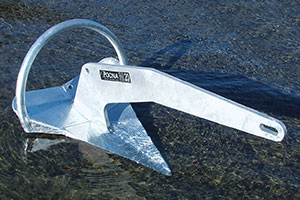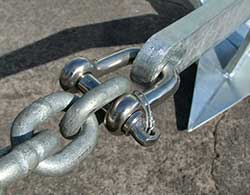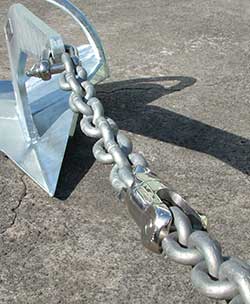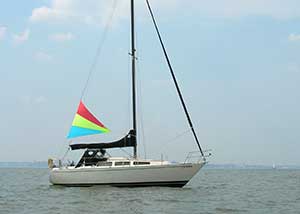
MEMBER’S HANDBOOK 2007
The Official Coastguard Northern Region Member’s Handbook
The Bottom Line: Anchoring Beyond 2007
Anchors are right at the heart of boating. They allow remote and wonderful places to be visited, without the benefit of a solid dock or even mooring buoy. Put that notion with the recent comments from yachts surviving (or not surviving as the case may be) the recent spat of hurricanes worldwide, and it is clear one of the most important pieces of equipment onboard is your anchor, and associated gear.
Anchor types
There are specialist and general purpose types. If you fish or dive and anchor over rock or reef, you will need a specialist rock anchor such as a grapnel – if you use a more conventional type, you will likely lose or damage it. No general purpose anchor is good for use on rock, no matter the claims of the manufacturer.
A general purpose type is to be used in the mud and sand conditions found around New Zealand. Here in Godzone the majority of boaters still carry the older generation anchors such as ploughs (e.g. CQR), claws (e.g Bruce), and flat-blade Danforth types. While popular after many years of use, these types do not offer the benefits of the newer generation type anchors on the market – which have raised the bar somewhat in expectations of anchoring performance. Inherent problems with the older anchor types include inconsistent setting performance (often not setting at all), poor holding in soft bottoms, and failure to penetrate in hard. There are type-specific issues also, such as the moving parts of hinged-shank plows, which can cause injury to crew as well as reducing strength; blade shapes designed to furrow (i.e. plough) through the ground, and the “hopping and skipping” behavior of claws together with their failure to reset.
While the “which anchor is best” debate will always create passionate argument, it is quite clear that the more traditional types are becoming out-dated, and the more modern designs asserting themselves as the superior choice.

These types include the French designed “Spade”, the German “Bügel”, and the New Zealand designed and built “Rocna”. The latter features a concave fluke for maximum holding power, a roll-bar to guarantee the correct setting attitude, and is hand fabricated right here in New Zealand. It is designed to set first time every time within a meter on any seabed, and offers superb holding. The Rocna is gaining an excellent reputation down under, and is being used by the Navy sail training division as well as a few Coastguard vessels.
Most anchors are built from galvanized steel, but stainless and aluminium options are sometimes available. The use of aluminium makes the anchor lighter, which makes it an ideal material for spare or auxiliary anchors, but this means the anchor may not set as well as its steel version, and is also makes it less strong. Stainless steel looks good but is invariably a bit weaker than regular steel, and is extremely expensive. Avoid cheap cast stainless anchors.
Most anchor designs have their inevitable copies or variations, frequently (but not always) hailing from China. Sometimes these copies add gimmicks as sales ploys or take shortcuts to cut costs but do little to further the technology. The wise consumer will consider the “you get what you pay for” factor, and remember that the original is usually best.
It is also prudent to have at least two anchors onboard – most boats will have a smaller kedge or stern anchor, but spares are important too. Serious cruising boats will have a small collection of anchors, stowed below if not in use.
Rode
The use of chain is strongly encouraged, either for all your rode (preferable) or as a leader of a length at least equal to that of the boat. Chain generates a catenary effect that provides shock absorption and keeps the pull on the anchor closer to horizontal, which is ideal. It also helps prevent the boat sailing around the rode and wears much better on a rough seabed. All this applies to any size boat.
Stainless steel chain will not “cone” in the chain locker, but is unavailable in strengths equal to galvanized options, and is much more expensive.
For long lengths of rope, polyester is generally superior to nylon, as the latter stretches which encourages “sailing” when at anchor. Three-strand nylon tends to harden in the marine environment and becomes difficult to handle, and tends to twist, and knot, under load. At the high end multiplait (either polyester or nylon) rope makes ideal anchor rode, as it is easy to handle, and stows in less space.

Below: Popular inline type swivel installed with a few links of chain between it and the anchor

The use of a chain-stop when anchored is recommended on larger boats in order to reduce stress on the windlass.
If an all-chain rode is being used, a snubber is advisable. This is a length of suitably sized nylon used with a chain claw that acts as a shock absorber to smooth out peak loads on the anchor. It also reduces vibrations (from the chain moving on the seabed) propagated through the chain into the boat, which results in noise (chain rumble).
The use of tested shackles is recommended, especially on anchor sizes of 15 kg (33 lb) and above. Stainless steel shackles are popular but care should be taken. A forged type is preferable, and cast versions should always be tested. Select the largest size possible given the maximum pin diameter that the chain links will accept. A well designed anchor such as the Rocna will have a slotted attachment point which will be large enough for the head of the shackle to fit through, avoiding the need to use two shackles.
The shackle must be seized with two turns of soft stainless steel or monel seizing wire. A short term solution is to use a suitably sized electrical cable tie. This prevents the pin from undoing itself, which it will do given a chance.
Swivels are a popular accessory helpful in reducing rope twist, particularly useful with three-strand ropes, and allowing the anchor to be rotated upon retrieval. A swivel should be rated to the breaking strength of the chain (not the working load), and care must be taken to avoid cheap and badly built designs.
When installing, be sure the swivel cannot be subjected to a veering load and can articulate properly. It is safe to put a meter or so of chain between the swivel and the anchor, rather than attaching the swivel directly to the anchor. If this is done, an articulating “ball-and-joint” design is pointless, and an in-line rotating design will be of simpler construction and probably a better solution.
Use your anchor without a swivel if you are unsure. You can always install one later if desired.
Deploying your anchor
Drop the anchor with the boat stationary or starting to drift back with the wind or tide. Try to let the rode out consistently – avoid piling the chain up on top of the anchor.
A 3:1 ratio of rode-length to water-depth is minimum (“1” being the vertical distance from the seabed to the bow roller, not the waterline). Generally speaking about 5:1 is appropriate. Even if you plan on using 3:1 (e.g. if the anchorage is crowded), set the anchor at 5:1 first. In any wind you can just let the bow wipe off; in calm conditions motor backward slowly. Be careful, especially if using a new generation anchor – they can dig in so quickly that any speed can damage equipment or crew. In bad conditions, the ratio should be increased to 7:1, or even higher if you feel the need.
The rode’s catenary effect on holding power is determined by the amount of chain and/or rope suspended between the boat and the seabed, so the need for a high ratio decreases with increasing depth. 3:1 should remain the minimum. In very shallow water you need more than normal. Then again, if your boat is in shallow water, it is probably well sheltered. There are many variables and common sense should dictate.
Remember to find a transit onshore, and watch along the sight-line in order to check whether you are dragging or not. After setting the anchor, you should check the transit once again about 10 minutes later, to verify the boat has not moved slowly in that time.
While set
Some boats will “sail” at anchor, which means they will continually ride up on the rode then fall back, or career from side to side. A high profile bow combined with a shallow underwater profile, typical of many powerboats, will exacerbate this.

(photo courtesy Banner Bay Marine)
The solution is to move the center of wind resistance farther aft, and this can be accomplished with the use of a riding sail. These are available designed for both sail and power boats.
You should display appropriate signals while at anchor, in order to let other mariners identify whether you are underway, drifting, or anchored. At night an all-round white light is required, and during the day, a spherical “anchor-ball” suspended from the rigging (to create a circular silhouette). Both should be sized according to the regulations for your vessel.
Retrieving your anchor
Although in normal conditions anchors are easily recovered using the rode, it is not uncommon for anchors to become caught on underwater objects such as rock, coral, cables, or even sunken wrecks. When fouled on such an object, the anchor may be difficult or impossible to retrieve by simply pulling on the rode. Applying large amounts of force in an attempt to dislodge the anchor in these circumstances risks damaging the anchor, your vessel, or associated equipment.
A solution to this is to use a buoyed retrieval line. This involves attaching a small buoy or other flotation device to the appropriate attachment point (most anchors have one) using a light rope of a length that is slightly greater than the depth of the water at high tide. The buoy will then float directly above the anchor. If attempts to retrieve the anchor in a normal fashion fail, the buoy may be picked up and the anchor lifted ‘backward’ using the retrieval line.
This technique has other advantages, such as alerting other mariners to the location of your anchor, and in an emergency you may abandon your anchor temporarily, and return later under controlled conditions knowing it will be easy to find.
Once you have pulled the anchor home, it is common to store it on your boat’s bow-roller. While the windlass, if you have one, will keep the anchor in place, it is unwise to rely solely on this. If the clutch should let go, your anchor and your rode will be headed for Davy Jones’ locker and the results may be disastrous. Therefore you should always restrain the anchor in some secondary manner, either with the chain stop (if present), or with lashing. Some boats are set-up with a restraining pin which fits through a hole in the anchor, but, especially on larger boats, this can be risky, as a large body of water hitting the anchor while at sea could bend the pin, so jamming it.
The Bottom Line
It is important to remember how critical your boat’s anchoring equipment is. Many cruising boats spend 95% of their time at anchor. During this time, the safety of the boat and the crew is often completely dependent on the anchor and rode. Do not put it at risk when choosing the gear – invest appropriately in good quality equipment, and learn how to use it properly.
